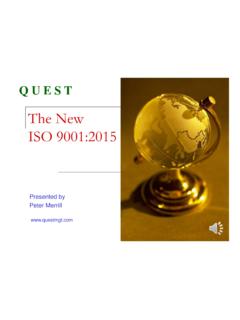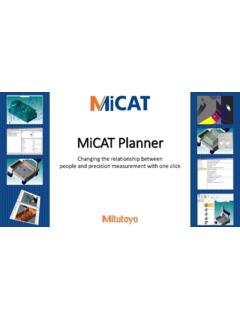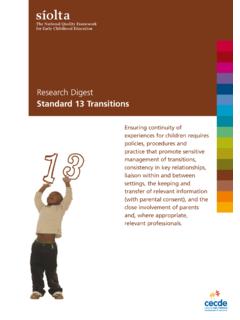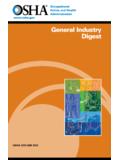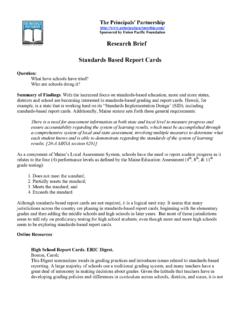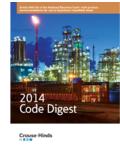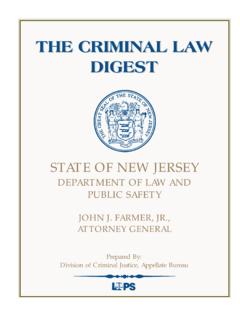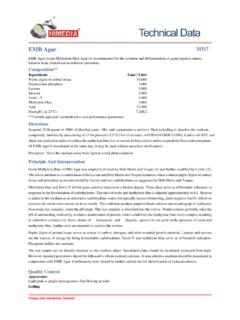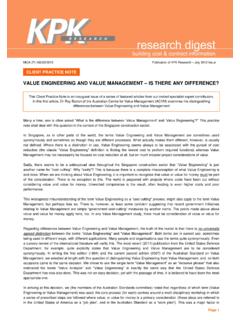Transcription of What’s New in the ASME Y14.5 2009 Standard - Quality Digest
1 1 Copyright by Multi Metrics, Inc. Menlo Park, CA 2009 - All Rights Reserved What s New in the asme 2009 Standard ! 2009-07-31 Bill Tandler With editorial contributions from Evan Janeshewski and Ron Grube Multi Metrics & SmartGD&T 1. Introduction In March 2009 the asme has released a new Standard , the first since 1994, and there is much in it of great interest and benefit. In order to help potential users decide whether or not to adopt it, we attempt to cast some light on its most important novelties. To set the stage, we start with a definition of GD&T as a whole, in order to be sure we are all on the same page. Next we ask why a new Standard might be interesting.
2 Finally, we provide a brief overview of the contents of this evaluation before we go into detail. What is GD&T? GD&T is a symbolic language with which to research, refine and finally encode the functions of each feature of a machine part by specifying permissible limits of imperfection to guarantee its operation, assemblability, manufacturability and inspectability. Whereas CAD is dedicated to communicating the geometry of a part, GD&T is dedicated to communicating its functional requirements.. Why do we need a new Standard ? standards always represent our best understanding of a topic at the time they are released. In most cases we keep learning as we go, and in the case of GD&T we have learned a lot since 1994.
3 The many changes contained in 2009 represent very useful advances and clarifications which will further empower the designer to fully and reliably express the desired functions of machine parts. In particular, they will result in significant benefits for Tolerance Stack-Up Analysis, for clear communication of manufacturing objectives, and for empowering coordinate metrology software. As we might suspect, however, not everything needing attention can be addressed in a new Standard , and there are a few disappointments which also need to be logged. Overview of the Most Important Changes: The most important changes in the 2009 Standard are presented in three groups.
4 Click on any topic to go there directly and then hit the Return button to come back, or simply scroll through the entire article. In order to fully comprehend much of this overview, it is imperative to have a copy of the 2009 Standard at hand to study the figures referenced in the explanations, which limited space does not permit us to duplicate here. 2. New and refined Concept Definitions 2a. Material Condition Modifiers 2b. Geometric Tolerance Value Modifier Details 2c. Material Boundary Modifier Details 2d. Datum Feature Simulators 2e. Datums 2f. Actual Mating Envelopes 3. New and refined Tools 3a. Datum (Feature Simulator) Translation Modifier: 3b. Degrees of Constraint Modifiers: [u,v,w,x,y,z] 3c.
5 Explicit Datum Feature Simulator Size and Location Modifiers: [BSC] / [ 15] SmartGD&T Analysis of the asme Y14,5 2009 Standard 2 Copyright by Multi Metrics, Inc. Menlo Park CA 2009 - All Rights Reserved 3d. Movable Datum Target (Simulator) Symbol 3e. Composite Feature Control Frames - Increased numbers of Tiers 3f. Datum Reference Frame Axis Identifiers: X[A,B,C], Y[A,B,C] and Z[A,B,C] 3g. Unequally Disposed Profile Modifier: (U) 3h. Non-Uniform Modifier: [NON-UNIFORM] 3i. ALL OVER Modifier: (()) 3j. Continuous Feature Modifier: <CF> 3k. Independency Modifier: (I) 3l. The True Modifier: TRUE 4. Disappointments 4a. Loss of the RFS and RMB Modifier Symbols (S) 4b.
6 Failure to Clean up or Eliminate the Concentricity & Symmetry Tools 4c. Failure to Clean up the Radius Tools 4d. Failure to Clarify the Datum Feature Shift Concept 4e. A Still only Partially Adequate Topic Index. 4f. Incomplete Explanation of the Functional Objectives of the Geometric Tolerance Value [Tolerance Zone Size] Modifier (L) 4g. Need to Eliminate the Term Resultant Condition and Refine the term Virtual Condition 4h. Inadequately Precise Definition of a Basic Dimension 4i. Need to Discontinue use of the Word True 2. New and Refined Nomenclature, Definitions & Effects 2a. Material Condition Modifiers - (S), (M) and (L) What: Clarification of Concepts and Separation of the Modifiers into two Groups: Geometric Tolerance Value and Material Boundary Modifiers , plus Elimination of the explicit Modifier (S).
7 Where: and Objective: To clearly differentiate between the effects and use of these modifiers when applied to tolerance values versus datum features. Ratings: Usefulness [high] In order to significantly clarify their different effects, the 2009 Standard separates the material condition modifiers (S) [no longer defined], (M) and (L) into the two functional groups defined below: 1) Geometric Tolerance Value modifiers when associated with tolerance values, and 2) Material Boundary modifiers when associated with Datum Features. Unfortunately, the 2009 Standard forbids explicit use of the symbol (S). For details, see Section ). Geometric Tolerance Value Modifiers: These modifiers are associated with the tolerance value in a feature control frame, and fix or permit an increase in the size of a tolerance zone.
8 They are decoded as follows when reading a Feature Control Frame: RFS = Regardless of Feature Size the default modifier [no symbol] MMC = at Maximum Material Condition symbol (M) LMC = at Least Material condition symbol (L) See Section of this document for clarification of their functional impact. SmartGD&T Analysis of the asme Y14,5 2009 Standard 3 Copyright by Multi Metrics, Inc. Menlo Park CA 2009 - All Rights Reserved Material Boundary Modifiers: These modifiers are associated with the Datum Features referenced in a feature control frame, and determine the stabilizing or mobilizing impact of Datum Feature Simulators during the Datum Reference Frame establishment process.
9 They are decoded as follows when reading a Feature Control Frame: RMB = simulated Regardless of the Material Boundary the default modifier [no symbol] MMB = simulated at the Virtual Maximum Material Boundary symbol (M) LMB = simulated at the Virtual Least Material Boundary symbol (L) See Section of this document for clarification of their functional impact. DETAILS Although the 2009 nomenclature changes for the individual modifiers provide substantial improvement by finally differentiating between their names in accordance with their different applicability, a last recommended step would be to rename their groups as follows, to provide a thoroughly visceral connection with their functions: 1) Current: Geometric Tolerance Value modifiers.
10 Recommended: Tolerance Zone Size modifiers. 2) Current: Material Boundary modifiers. Recommended: Tolerance Zone Mobility modifiers. The intrinsic purpose of Feature Control Frames is to define the shape and size of tolerance zones, and the coordinate systems relative to which they are to be oriented and located. The impact of the newly named Geometric Tolerance Value modifiers is to specify whether a tolerance zone is to be fixed in size in the presence of the RFS modifier, or be free to expand in the presence of an MMC or LMC modifier. They are in fact Tolerance Zone Size modifiers. Why not call them that? The impact of the newly named Material Boundary modifiers is to determine the permissible mobility of a Datum Reference Frame relative to a particular Datum Feature by specifying the behavior of its simulator.

